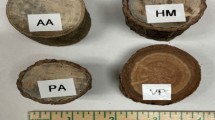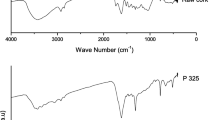Abstract
In this work selected biomass (Afzelium Africana (apa wood), Milicia excels (iroko wood), and Elaeis guineensis (palm kernel shell)) were converted to char, liquid, and gaseous products in a fixed-bed reactor using pyrolysis process at different temperatures (400, 500, 600, 700, and 800 °C). The amount of char produced from the process decreased with increasing temperature severity across species. The industrial application qualities of the produced charcoal regarding high fixed carbon, content and percentage carbon, lower moisture content, volatile matter, sulphur and ash contents were obtained at high temperature and heating rate for all species. The carbon content of the produced charcoals approached absolute values between 600 and 800 °C for all species, making temperature severity a factor at upgrading biomass energy content. Temperature and heating rates are therefore considered as major factors for producing industrial charcoals that is more reactive (rich in carbon), smokeless in quality and harder in texture across biomass species.


Similar content being viewed by others
References
Antal, M.J., Grønli, M.: The art, science, and technology of charcoal production. Ind. Eng. Chem. Res. 42(8), 1619–1640 (2003)
ASTM: Standard test methods for particulate woods. ASTM international, West Conshohocken, PA, pp. 19428–2959: 106–110; 153; 292–293 (2007)
Bridgwater, A.V.: A guide to fast pyrolysis of biomass for fuel and chemicals. Aston University Pyne Guide I, U.K: I-V (1999)
Diebold, J.P., Bridgwater, A.V.: Overview of fast pyrolysis of biomass for the production of liquid fuels. In: Development in thermochemical biomass conversion, vol. 1, pp. 5–24. UK (1997)
Dietrich, M., Oasmaa, A.: Update on the analysis and characterisation subject group. Pyne-subject Group, Netherlands. Issue 7 (1999)
Edward, B.R.: Charcoal: description of the products and its uses. EBC Company, 222 Franklin (2000)
Lucas, E.B., Fuwape, J.A.: Combustion - related and some other characteristis of six nigerian plant species concerning their suitability as domestic fuels. Nigerian J. Solar Energy 2, 89–97 (1982)
Meszaros, E., Jakab, E., Varhegyi, G., Bourke, J., Manley-Harris, M., Nunoura, T., Antal, M.J.: Do all carbonized charcoals have the same chemical structure? 1. Implications of thermogravimetry-mass spectrometry measurements. Ind. Eng. Chem. Res. 46, 5943–5953 (2007)
Raph, P.O.: Thermochemocal conversion of biomass in renewable energy sources charged with energy from the sun and originated from Earth—Moon interaction. In: Encyclopedia of life support system (EOLSS). Developed under the Auspices of the UNESCO-EOISS Publisher, Oxford. http://www.eolss.net. (2004)
Richardson, J., Bjorheden, R., Hakkila, P., Lowe, A.T., Smith, C.T.: Bioenergy from sustainable forestry: guiding principles and practice. Kluwer, Forestry Sciences. 71:44. Dordrecht, The Netherlands (2002)
Skodra, G., Amarantos, P.S.: Overview of low temperature carbonisation. Centre for Research and Technology Hellas and Institute of Solid fuel Technology and Applications (CE.R.T.H./I.S.F.T.A.) (2004)
FAO: Industrial charcoal making. FAO Forestry Paper No. 63, Rome (1985)
FAO: Integrated energy systems in China—the cold north eastern region experience. Food and Agriculture Organization of the United Nations Rome. Paper No.9408. http://www.fao.org/docrep/t447oe0ahtm#7%20the%20res (1994)
FAO: Forests, fuel and the future—wood energy for sustainable development—Forestry topics report no. 5. Forestry Department Food and Agriculture Organization of the United Nations. Viale delle Terme di Caracalla 00100 Rome, Italy (1995)
FAO: Development of a sustainable charcoal industry: industrial charcoal production. TCP/CRO/3101 (A) Zagreb, Croatia www.drveniugljen.hr (2008)
Fapetu, O.P: Energy conversion and utilisation from biomass. Towards minimization of environment impacts. A seminar Paper, delivered at the Polytechnic, Owo. Ondo State, Nigeria (1995)
Fuwape, J.A.: Effects of carbonisation temperature on charcoal from some tropical trees. Biores. Technol. 57, 91–94 (1996)
Gaskin, J.W., Steiner, C., Harris, K., Das, K.C., Bibens, B.: Effect of low-temperature pyrolysis conditions of biochar for agricultural use. Transactions of the ASABE. Am. Soc. Agric. Biol. Eng. 51(6):2061–2069 (2008)
Hall, J.P.: Sustainable production of woody biomass for energy. XII World Forestry Congress. Quebec City, Canada.0077-A1. Canadian Forest Service, Ottawa, K1A 0E4. phall@nrcan.gc.ca (2003)
Kurma, M., Gupta, R.C.: Industrial uses of wood char. Energy Res. 20, 575–589 (1998)
McKendry, P.: Energy production from Biomass (Part 1): overview of Biomass. Bioresourc. Technol. 83: 37–46 (2002a)
McKendry, P.: Energy production from biomass (Part 2): conversion technologies. Bioresourc. Technol. 83: 47–54 (2002b)
Meier, D., Faix, O.: State of the art of fast pyrolysis of lignocellulosic materials- a review. Bioresour. Technol. 68, 71–77 (1999)
Mucuk, M.M., Damirbas, A.: Biomass conversion processes. Energy Convers. Manage. 38(2), 151–165 (1997)
Murkovic, M., Bornik, M.: Formation of 5-hydroxymethyl-2furfural (HMF) and 5-hydroxymethyl-2-furoic acid during roasting of coffee. Mol. Nutr. Food Res. 51, 390–394 (2007)
Quilty, J.R., Cattle, S.R.: Use and understanding of organic amendments in Australian agriculture: a review. Soil Res. 29, 1–26 (2011)
Saranya, K., Santhana, P., Kumutha, K., French, J.: Potential for biochar as an alternate carrier to lignite for the preparation of biofertilizer in India. Int. J. Agril. Environ. Biotech. 4(2), 167–172 (2011)
Sevgi, S.: Slow pyrolysis of wood barks from Pinus brutia Ten and product compositions. Bioresour. Technol. 89, 307–311 (2003)
Shinya, Y., Yokihiko, M.: The Asian biomass production and utilization. Japan Institute of Energy. Asian Biomass Handbook. www.jie.or.jp/biomass/AsiaBiomassHandbookE-080917.pdf. Accessed 18 July 2010 (2008)
Titiladunayo, I.F., McDonald, A.G. and Fapetu, O.P.: Development of a fixed-bed pyrolysis reactor from local materials for thermochemical conversion of lignocellulosic biomass. J. Biobased Mater. Bioenerg. (2012) Submitted
White, J.P., Plaskett, L.G: Biomass as Fuel. Published by Academic Press 111 Fifth Avenue New York 10003.Published in London by Academic Press Inc. (London) Ltd. 24/28 Oval Road. London NWI &DX, (1981)
Zhengwen, H., Jianliang, Z., Haibin, Z., Mi, T., Zhengjian, L., Tianjun, Y.: Substitution of biomass for coke in iron making process. Advanc. Mater. Res. 236–238, 77–82 (2011)
Acknowledgments
The Authors appreciate University of Idaho and gratefully acknowledge the funding from USDA-CSREES Wood Utilization Research program grants (2008-34158-19486 and 2009-34158-20170) for making the completion of this work possible.
Author information
Authors and Affiliations
Corresponding author
Rights and permissions
About this article
Cite this article
Titiladunayo, I.F., McDonald, A.G. & Fapetu, O.P. Effect of Temperature on Biochar Product Yield from Selected Lignocellulosic Biomass in a Pyrolysis Process. Waste Biomass Valor 3, 311–318 (2012). https://doi.org/10.1007/s12649-012-9118-6
Received:
Accepted:
Published:
Issue Date:
DOI: https://doi.org/10.1007/s12649-012-9118-6




